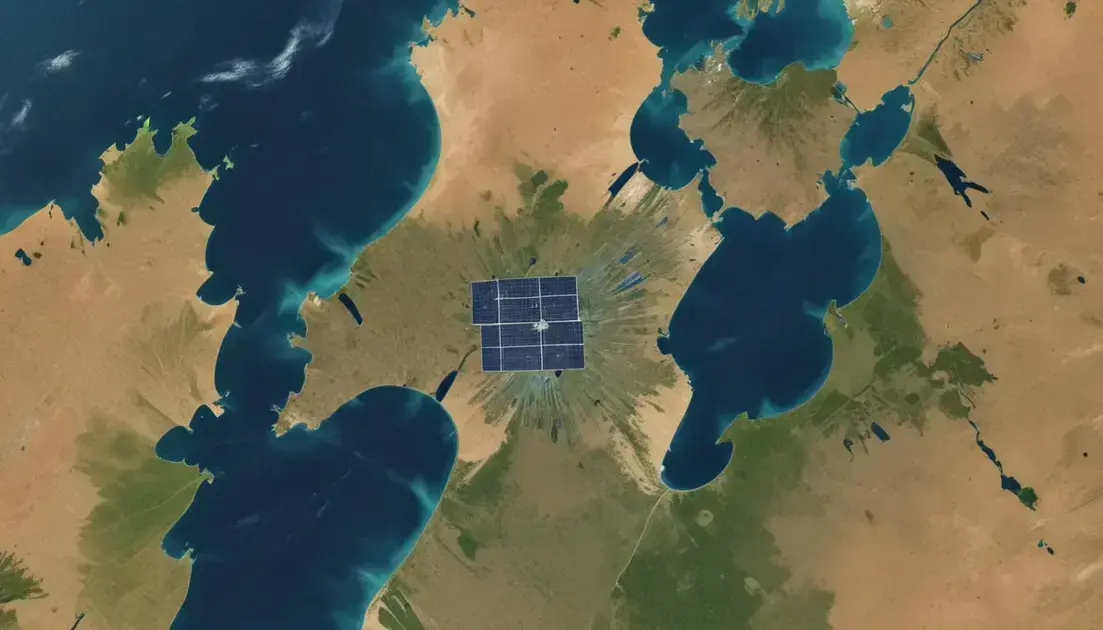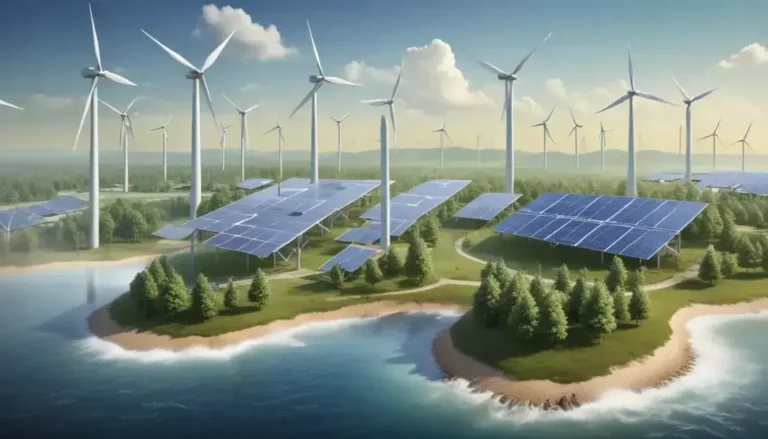How Global Renewables Watch Aids Renewable Energy Growth
Renewable energy is crucial for combating climate change, offering sustainable alternatives to fossil fuels while promoting economic growth and energy security through technological advancements and supportive policies.
In the quest for sustainable energy, the renewable energy sector is crucial. Let’s dive into how Global Renewables Watch, a groundbreaking initiative, maps and tracks this progress.
Introduction to Global Renewables Watch
The Global Renewables Watch initiative leverages advanced technology to provide real-time tracking and insights into the renewable energy landscape. This platform is designed to rigorously monitor the deployment of renewable energy sources worldwide, ensuring that all stakeholders can access crucial data and trends.
With its state-of-the-art mapping technology, Global Renewables Watch consolidates information on solar, wind, and other renewable sources in one accessible interface. This allows policymakers, researchers, and industry leaders to make informed decisions based on the most current data available.
Through the integration of cloud-based systems and satellite monitoring, the initiative enhances transparency, enabling users to visualize energy installations and their performance over time. This information is invaluable for formulating policies that promote cleaner energy alternatives and addressing climate change challenges.
Global Renewables Watch also plays a pivotal role in public engagement by showcasing the benefits of renewable energy. By highlighting successful projects and innovations, it inspires communities and individuals to participate in the transition towards a sustainable energy future. The initiative ultimately aims to create a collaborative environment where knowledge-sharing drives advancements in the renewable sector.
Role of Microsoft in Renewable Energy
Microsoft has emerged as a key player in driving the renewable energy agenda forward. With ambitious sustainability goals, the company aims to become carbon negative by 2030. This commitment underscores its dedication to fostering a cleaner environment through innovative energy solutions.
One of the most significant contributions from Microsoft is its investment in renewable energy projects. The company actively purchases renewable energy to power its vast global operations. This not only reduces its carbon footprint but also boosts the market for sustainable energy sources.
Additionally, Microsoft is leveraging its cloud computing platform, Azure, to enhance energy efficiency. By providing advanced data analytics and AI tools, Azure enables organizations to optimize their energy consumption and integrate renewable sources effectively. This technological support plays a vital role in advancing the renewable energy sector.
Through partnerships with various energy providers and stakeholders, Microsoft is also focused on creating a roadmap for sustainable energy practices. This collaboration helps to promote innovations in the field and encourages a collective effort towards a greener future. Ultimately, Microsoft’s role exemplifies how major tech companies can lead by example, championing the transition to a sustainable energy ecosystem.
Mapping and Monitoring Renewable Installations
Mapping and monitoring renewable energy installations are essential for understanding the growth and impact of sustainable energy sources. Using advanced technologies, stakeholders can visualize the distribution of renewable resources such as solar and wind energy across various regions.
This process involves the utilization of Geographic Information Systems (GIS) and satellite imagery, providing comprehensive insights into site locations and performance metrics. By applying these tools, organizations can identify optimal sites for new installations, ensuring efficient energy production.
Additionally, continuous monitoring of existing installations allows for performance optimization and maintenance planning. Real-time data analysis helps detect issues early, minimizing downtime and maximizing energy output. This proactive approach fosters reliability in the renewable energy sector.
Moreover, mapping initiatives support regulatory compliance and facilitate transparent reporting to stakeholders, including investors and the community. By showcasing the progress and benefits of renewable installations, these efforts drive public awareness and support for future projects. Overall, effective mapping and monitoring contribute significantly to the advancement of renewable energy as a viable alternative, promoting a cleaner and more sustainable future.
Key Findings from the Atlas
The Key Findings from the Atlas reveal essential insights into the global renewable energy landscape. The Atlas serves as a comprehensive resource that compiles data on renewable energy installations, enabling stakeholders to understand trends and regional variations.
One significant finding indicates that regions with strong policy support for renewables exhibit faster growth rates. This correlation emphasizes the need for robust legislative frameworks to encourage investment in sustainable technologies. Furthermore, the Atlas highlights the increasing accessibility of renewable energy resources in previously underserved areas, indicating progress towards equitable energy distribution.
Another vital insight from the Atlas is the diversity of renewable sources utilized worldwide. While solar and wind technologies dominate, other alternatives such as hydro and geothermal energy also play crucial roles in local energy mixes. This diversification is essential for enhancing energy security and resilience.
Additionally, the data underscore the importance of community-driven initiatives in achieving renewable energy expansion. Local projects often lead to increased public awareness and engagement, reinforcing the societal benefits of transitioning to renewable energy. Overall, the findings from the Atlas provide a valuable foundation for policymakers, businesses, and researchers committed to promoting a sustainable energy future.
Impact on Policy and Energy Decisions
The impact of renewable energy on policy and energy decisions is profound and increasingly relevant. As global awareness of climate change grows, policymakers are prioritizing renewable energy sources in their strategic frameworks. This shift is evident in the implementation of incentives for solar and wind energy development, as well as tax benefits for companies that adopt sustainable practices.
Furthermore, governments are setting ambitious targets for reducing carbon emissions, often establishing legal frameworks that mandate a transition to sustainable energy. As a result, businesses are adjusting their operational strategies to align with these policies, leading to increased investments in renewable technologies.
In addition to regulatory support, public opinion is shaping energy decisions. There is a growing demand from consumers for cleaner energy options, compelling companies to respond by integrating renewables into their offerings. This consumer-driven approach amplifies the importance of transparency and corporate responsibility, as companies seek to align with societal values.
Moreover, international agreements, such as the Paris Agreement, are impacting national policies. Countries are collaborating to establish shared goals and working together to achieve a sustainable energy future. These factors collectively illustrate the critical influence of renewable energy on shaping policy and driving transformative energy decisions worldwide.
In Conclusion: Embracing Renewable Energy for a Sustainable Future
The significance of renewable energy in today’s world cannot be overstated. As we have explored, the advancements in technology and supportive policies are driving a shift toward sustainable energy sources.
By understanding the key findings from various studies, investing in renewable projects, and recognizing consumer demands, businesses and governments can make informed decisions that positively impact our environment.
Furthermore, collaboration between stakeholders and the community is essential in promoting clean energy initiatives. This collective effort not only addresses climate change but also fosters economic growth and energy security.
Ultimately, embracing renewable energy is not just a choice; it is a responsibility we all share. Together, we can create a cleaner, greener, and more sustainable future for generations to come.
Frequently Asked Questions
What is the role of renewable energy in combating climate change?
Renewable energy plays a crucial role in reducing greenhouse gas emissions, helping to combat climate change by providing cleaner alternatives to fossil fuels.
How can businesses benefit from investing in renewable energy?
Investing in renewable energy can lead to cost savings, improved brand reputation, and compliance with regulations, making businesses more sustainable and attractive to customers.
What technologies are used to monitor renewable energy installations?
Technologies such as Geographic Information Systems (GIS) and satellite imagery are used to effectively map and monitor renewable energy installations.
Why is policy support important for renewable energy growth?
Policy support is vital as it creates a favorable environment for investments, encourages innovation, and ensures a clearer path toward achieving sustainability goals.
How can communities engage with renewable energy initiatives?
Communities can engage by participating in local renewable energy projects, advocating for clean energy policies, and educating others about the benefits of renewable resources.
What are the key findings from the Global Renewables Watch Atlas?
The Atlas provides insights on the distribution of renewable energy resources, highlighting trends, regional growth, and the importance of policy support for sustainability.






